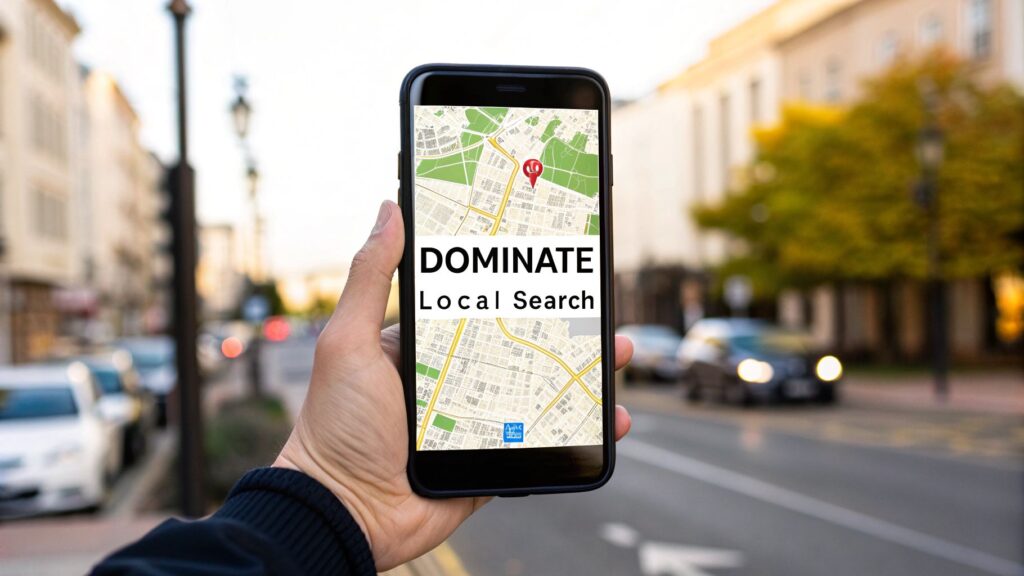Running a busy audiology practice is a full-time job. Between patient care and managing your clinic, marketing often takes a backseat. But if you focus on one strategy to grow, it should be Search Engine Optimization (SEO).
Why? Because today, the path to your clinic's door starts with a Google search. This guide breaks down SEO for audiologists into simple, actionable steps.
Why SEO is Your Best Patient Magnet
Think from a patient's perspective. When they notice hearing loss or tinnitus, they don't look in the Yellow Pages. They grab their phone and search "audiologist near me" or "hearing test in Dallas."
SEO is about making sure your practice shows up in that exact moment.
Unlike ads that interrupt people, SEO connects you with patients who are already looking for your services. You're not an interruption; you're the solution they were searching for.

Connect With High-Intent Patients
Someone searching "best hearing aids for tinnitus" has a real problem. They are actively looking for a professional to solve it. Ranking high for these terms puts your practice first in line.
In Short: Patient intent is the secret sauce of SEO. These aren't cold leads; they are motivated people who need your expertise.
The data supports this. SEO drives over 1,000% more website traffic than organic social media. With 28% of patients clicking the very first search result, being at the top is the best way to fill your schedule. You can learn more about how SEO fuels growth for audiology practices here.
Build Long-Term, Sustainable Growth
Paid ads are a quick boost. But when you stop paying, you disappear. SEO is different. It’s an investment in your website, your practice's most valuable digital asset.
SEO is like planting a tree. It takes consistent care at first, but it delivers value for years with little ongoing cost.
Every blog post, patient review, and technical update builds on itself. This creates a compounding effect, generating a steady stream of patient calls without a constant ad budget.
Here’s how SEO directly benefits your audiology clinic:
- Boosts Local Visibility: It puts you on the map, making it easy for local residents to find you.
- Builds Trust: A high Google ranking tells patients you are an established, credible expert.
- Delivers Incredible ROI: The long-term value of attracting patients organically far outweighs the cost of paid ads.
SEO vs. Other Marketing for Audiology Clinics
| Marketing Channel | Patient Intent | Cost Over Time | Long-Term Practice Value |
|---|---|---|---|
| SEO | Very High (Actively seeking care) | Decreases as authority grows | High (Builds a lasting asset) |
| PPC/Google Ads | High (Searching for solutions) | Stays constant or increases | Low (Visibility stops when you stop paying) |
| Social Media Ads | Low (Passive, not searching) | Stays constant or increases | Low (Brand awareness, not direct leads) |
| Direct Mail | Very Low (Unsolicited) | High per campaign | Very Low (One-time impact) |
A smart SEO strategy doesn't just bring you website visitors. It brings you the right visitors and turns your website into a 24/7 patient-generating machine.
Get Found Locally with Google Business Profile
For an audiology practice, your local community is everything. Winning at local search starts with your Google Business Profile (GBP).
Think of your GBP as your clinic's digital front door. It's often the first impression a potential patient gets of your practice.
When someone searches "audiologist near me," the map box that appears is your GBP. A neglected profile is a "Closed" sign. An optimized one is a patient magnet.
Nail the Basics of Your Profile
First, accuracy is everything. Google rewards businesses that provide reliable information.
Let's start with the fundamentals.
- Practice Name: Use your real, official business name. Don't stuff it with keywords like "Best Audiologist in Springfield." This can get your profile suspended.
- Address: Your physical location must be 100% correct, down to the suite number. This helps patients find you and proves you are a legitimate local business.
- Phone Number: Use a local phone number with a local area code. It’s a huge trust signal for Google and patients.
This core information is your NAP (Name, Address, Phone Number). It must be identical everywhere it appears online. Inconsistencies hurt your local search rankings.
Choose Categories That Attract the Right Patients
After your NAP, your business categories are the most powerful part of your profile. This is how you tell Google what you do.
Your primary category must be "Audiologist." That's non-negotiable.
But the magic is in the secondary categories. These help you capture more specific searches.
Pro Tip: Think like a patient. While "Audiologist" is the technical term, someone might search for "tinnitus specialist." Adding the right secondary categories helps you show up for these searches.
Examples of secondary categories for an audiology practice include:
- Hearing Aid Store
- Hearing Aid Repair Service
- Tinnitus Specialist
Selecting these increases your chances of appearing for searches like "hearing aid repair near me."
Turn Your Profile Into a Patient Resource
A basic profile gets you on the map. A detailed profile convinces a searcher to become a patient.
Write a Compelling Description: Use the description to tell your story. Mention specializations (like pediatric audiology) and what makes your patient experience unique.
Upload High-Quality Photos: Trust is built with visuals. Upload clear photos of:
- The outside of your clinic
- Your reception and waiting area
- Your exam rooms and equipment
- Friendly photos of you and your staff
Use the Q&A Feature: Proactively answer common questions. You can add your own questions like "Do you accept insurance?" and then post the answers.
Patient Reviews: Your Local SEO Superpower
Reviews are a massive ranking factor. They provide social proof that tells Google and patients that your practice is trusted.
You need a steady stream of recent, positive reviews.
Don't be afraid to ask for them. When a patient has a great experience, simply ask them to leave a review on Google. Also, respond to all reviews, good and bad. A thoughtful reply shows you value patient feedback.
Optimizing your GBP is one of the highest-impact SEO tasks you can do. For more advanced strategies, our guide on local maps SEO can help you dominate the map pack.
Find Keywords Your Patients Actually Use
Effective SEO for audiologists starts by getting inside a patient's mind. You need to know the words they type into Google when they worry about their hearing. This is called keyword research, and it's the foundation of everything.
We need to move beyond generic terms like "audiologist." The real magic is uncovering phrases people use when they're ready to make an appointment.

Think Like a Patient, Not a Practitioner
The biggest mistake audiologists make is using clinical jargon instead of simple language. Your patients don't search for "vestibular rehabilitation." They search for "dizziness treatment."
Brainstorm a list of problems you solve. Forget official service names.
- Ringing in my ears
- Can't hear in crowded restaurants
- My kid failed their school hearing test
- How much do hearing aids cost?
- My grandpa keeps turning the TV up too loud
Each pain point is a potential keyword. They represent a real person looking for a solution you provide.
Uncover "High-Intent" Keywords
A high-intent keyword is a search phrase that signals someone is ready to make a decision. Targeting these is how you get your phone to ring.
Consider the difference in mindset:
- Low Intent: "what is tinnitus" (This person is just researching.)
- High Intent: "best audiologist for tinnitus in [Your City]" (This person is looking to book an appointment.)
Common patterns for high-intent keywords include:
- Service + Location: "pediatric hearing test Boston"
- Problem + Location: "tinnitus relief Chicago"
- "Best" or "Top-Rated" Keywords: "best rated audiologist near me"
- Question-Based Keywords: "where can I get a hearing test"
In Short: Your job is to find the phrases that bridge a patient's problem to your practice's solution.
Use Free Tools to Find Keywords
You don't need expensive software. Google provides the best tools for free.
1. Google "People Also Ask"
Type a phrase into Google and look for the "People Also Ask" (PAA) box. This is a list of real questions people are asking. Use them for blog post ideas.
2. Google Autocomplete
Start typing a phrase like "hearing aids…" into the search bar. Google's suggestions are popular, real-world searches.
3. Google Keyword Planner
This free tool shows how many people search for a term each month. This data helps you prioritize which keywords to target first. You can learn more about using Google's Keyword Planner to find great terms for your practice.
Finally, create a simple keyword map. Assign your target keywords to the most relevant pages on your website.
For example:
- "Audiologist [Your City]" → Homepage
- "Tinnitus treatment" → Tinnitus Service Page
- "How to clean hearing aids" → A new blog post
This process ensures every page on your site has a clear purpose and is tuned to attract the right kind of visitor.
Build a Website That Turns Clicks into Patients
Getting potential patients to your website is only half the battle. If your site is confusing or slow, they will hit the back button and go to a competitor.
The goal of your website is to turn traffic into appointments.
This means balancing on-page SEO for search engines and user experience (UX) for people. A website that is easy for a person to use is exactly what Google wants to rank at the top. This is a core part of any good SEO for audiologists strategy.
Craft Pages That Speak to People and Google
Every page on your website needs a clear purpose. Your service pages, like "Tinnitus Treatment," must offer detailed, reassuring information.
On-page SEO leaves breadcrumbs for Google to understand what each page is about.
Here are the key elements to get right:
- Page Titles (Title Tags): This is the blue link in search results. It needs to be clear and include your main keyword. For example:
Tinnitus Treatment in [Your City] | [Your Practice Name]. - Headings (H1, H2, H3): Headings give your content structure. They help Google and people scan the page easily.
- Clear Calls-to-Action (CTAs): Use obvious, action-focused buttons like "Schedule a Consultation" or "Call Us Today."
Think of it like organizing a filing cabinet. The labels help everyone find what they're looking for.
Why Your Site Must Work Flawlessly on a Phone
Your website has to function perfectly on a smartphone. It's not a suggestion. More than half of all web traffic comes from mobile devices.
Websites that are fast and easy to navigate on a phone get more scheduled appointments. Find out more about turning your audiology website into a patient magnet on onspirehealthmarketing.com.
Picture a potential patient squinting at their phone, trying to pinch and zoom a desktop site on a tiny screen. They will give up. A mobile-friendly design is fundamental to earning a patient's trust.
A great mobile experience means:
- Text is easy to read.
- Buttons are large and easy to tap.
- Your phone number is "clickable" to call you directly.
- The site loads without frustrating delays.
Make It Easy for Patients to Connect
When a visitor decides you're the right audiologist, make it simple for them to reach out.
Put Contact Info Front and Center
Your phone number and address should be in the header or footer of every single page. This builds confidence and shows you're an accessible practice.
Keep Your Forms Simple
If you have an appointment request form, keep it short. All you need is a Name, Phone Number, and Email. A long form feels like homework.
By building a website that's optimized for search engines and helpful for people, you create a machine for attracting new patients.
Use Content to Build Trust and Authority
Your website's content is your first handshake with a potential patient. It's how you prove you are the local expert in hearing health. This isn't about churning out blog posts; it's about answering the real questions your community is asking.
When a person feels your website understands their concerns, they are more likely to choose you. This is how effective SEO for audiologists works. You become a helpful resource, which positions you as the go-to authority.

This strategy has a huge impact. Audiology websites with a patient-first mindset generate two to three times more new patient leads than competitors. This comes from proactively answering questions. You can learn more about patient-focused website design for audiologists on medpb.com.
Answer Questions Patients Are Actually Asking
Your content strategy should solve problems for people. Think about the common questions you hear every day in consultations. Turn those into helpful articles.
Instead of writing generic posts, get specific.
- ‘5 Signs You Might Need a Hearing Test’: This guides people toward taking action.
- ‘How to Choose the Right Hearing Aid Style for Your Lifestyle’: This helps patients with a complex decision and builds trust.
- ‘What’s the Difference Between an Audiologist and a Hearing Aid Dispenser?’: This educates your audience and highlights your expertise.
Your blog isn't just an SEO task. It's your first conversation with a patient. Each article is a chance to be helpful, reassuring, and clear.
Focus on Education, Not a Hard Sell
The goal is to educate, not to sell. No one wants to read a high-pressure sales pitch. Focus on providing genuine help. When you give away valuable information freely, you build goodwill.
This means your content needs to be:
- Empathetic: Acknowledge the patient's worries.
- Clear: Ditch clinical jargon. Explain complex topics in simple terms.
- Actionable: Give readers clear next steps, like a tip for talking to family or encouragement to book a test.
A blog post about tinnitus shouldn't be a list of definitions. It should explore coping strategies and explain management options in a way that provides hope.
How do I find blog topics for my audiology practice?
Coming up with topics is easier than you think. You just need to listen.
- Use "People Also Ask" on Google: Type a phrase like "hearing loss" into Google and see the questions that appear. These are what people are searching for right now.
- Ask Your Staff: Your front desk staff and audiologists hear the same questions over and over. Keep a running list.
- Review Your Consultation Notes: What are the most common concerns that come up during appointments? Each one is a potential blog post.
This process ensures your content is always relevant and speaks to the needs of the people you want to help.
Your 90-Day SEO Game Plan
Let's turn this information into a practical plan. Successful SEO for audiologists is about taking small, consistent steps.
Think of this as your roadmap. We'll focus on tasks that give you the biggest impact right away, so you can see real progress without feeling overwhelmed.
The process is a cycle: figure out what patients want, adjust your website to meet that need, see what works, and repeat.

It’s a continuous loop: research, optimize, and monitor to improve.
Your First Month: Lay the Foundation
This month is about setting up a solid base.
- Perfect Your Google Business Profile: Check every detail—name, address, phone number, hours—for 100% accuracy.
- Upload Fresh Photos: Add at least 10 new, high-quality photos. Show off your clinic, waiting room, and friendly staff.
- Expand Your Categories: Add relevant secondary categories like "Hearing Aid Store" or "Tinnitus Treatment Center."
Your Google Business Profile is the most powerful tool in your local SEO arsenal. It's often the first impression a patient gets. Make it a great one.
Your 90-Day Mission: Build Authority
With a strong foundation, the next three months are about creating helpful content.
- Plan Your First Three Blog Posts: Find three common patient questions and turn them into helpful articles. Think "What to Expect at Your First Hearing Test."
- Start Your Review Engine: Create a simple way to ask happy patients for a Google review. A follow-up email with a direct link works wonders.
- Give Your Website a Check-Up: Look at your site from a patient's perspective. Is your phone number clickable on mobile? Are your forms simple? Running a comprehensive SEO audit can uncover easy-to-fix issues.
Stay on the Right Path
Consistency is everything in SEO. This is a marathon, not a sprint.
If you can set aside just one hour per week for these tasks, you will see significant growth over time.
Use a free tool like Google Search Console to watch your keyword rankings and website traffic. Seeing those numbers go up is great motivation.
If you find you don't have that extra hour, looking into local SEO services for small businesses can put an expert in your corner. But by following this plan, you have a fantastic starting point.
People Also Ask: Common SEO Questions
As you start this process, you probably have a few questions. Here are some of the most common ones from audiologists.
How long does it take for SEO to work for an audiology practice?
SEO is a long-term strategy, not an instant fix. You might see early positive signs, like better map rankings, within 3 to 4 months. For a steady, noticeable flow of new patients, plan on 6 to 12 months of consistent effort. Results depend on local competition and the current state of your website.
What is the most important first step in SEO for an audiologist?
If you do only one thing, claim and completely optimize your Google Business Profile (GBP). It is the absolute cornerstone of local SEO. A complete, accurate profile with great photos and reviews is the single fastest way to get in front of local patients.
Should I do SEO myself or hire an agency?
You can definitely start on your own. Managing your GBP, asking for reviews, and writing a blog post are great DIY tasks. As your practice grows, you might find that technical SEO feels like a second job. That’s when many audiologists hire an agency to handle the heavy lifting and get faster results.
Is Your Business Ranking in Google Maps?
Turn Google Maps into a Lead Engine w/ Clicks Geek’s AI-powered local SEO. 3,000+ clients served. Our proprietary, fully done-for-you Maps SEO system handles everything—keyword targeting, local optimization, content, reviews, and ranking strategy—automatically.






